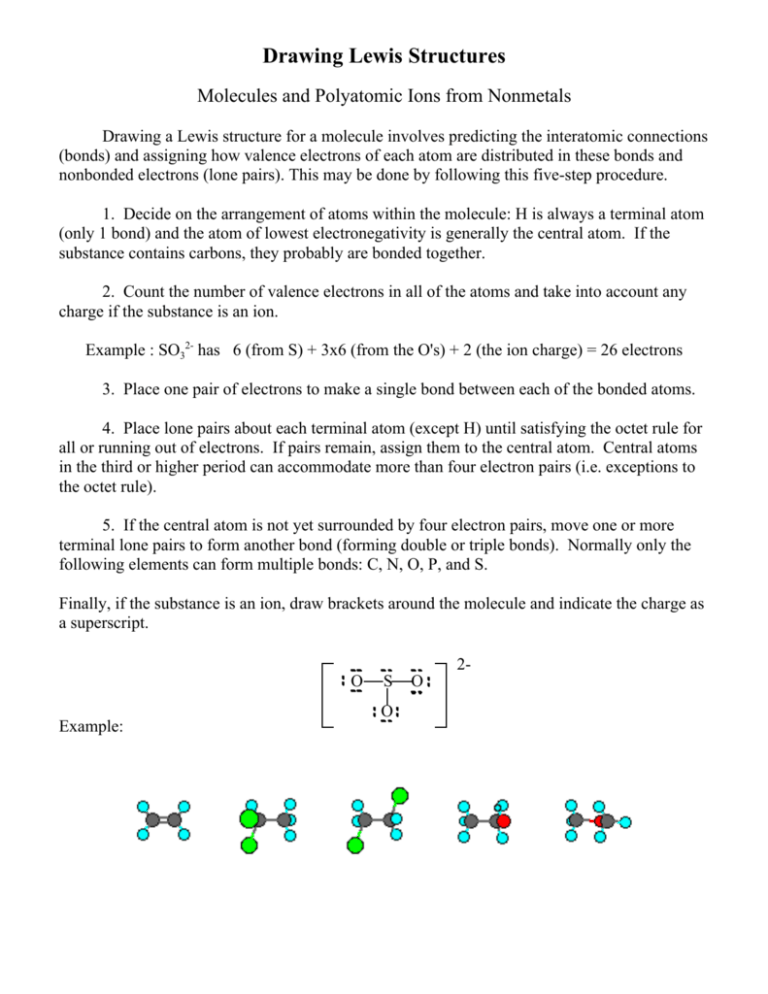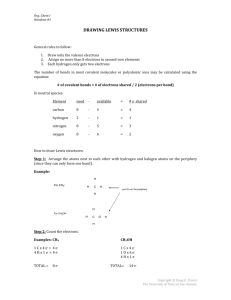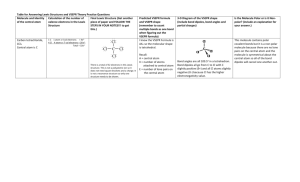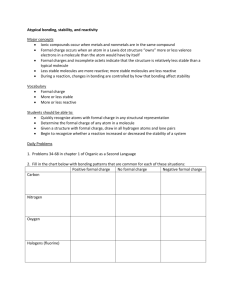Rules for Drawing Lewis Structures
advertisement

Drawing Lewis Structures Molecules and Polyatomic Ions from Nonmetals Drawing a Lewis structure for a molecule involves predicting the interatomic connections (bonds) and assigning how valence electrons of each atom are distributed in these bonds and nonbonded electrons (lone pairs). This may be done by following this five-step procedure. 1. Decide on the arrangement of atoms within the molecule: H is always a terminal atom (only 1 bond) and the atom of lowest electronegativity is generally the central atom. If the substance contains carbons, they probably are bonded together. 2. Count the number of valence electrons in all of the atoms and take into account any charge if the substance is an ion. Example : SO32- has 6 (from S) + 3x6 (from the O's) + 2 (the ion charge) = 26 electrons 3. Place one pair of electrons to make a single bond between each of the bonded atoms. 4. Place lone pairs about each terminal atom (except H) until satisfying the octet rule for all or running out of electrons. If pairs remain, assign them to the central atom. Central atoms in the third or higher period can accommodate more than four electron pairs (i.e. exceptions to the octet rule). 5. If the central atom is not yet surrounded by four electron pairs, move one or more terminal lone pairs to form another bond (forming double or triple bonds). Normally only the following elements can form multiple bonds: C, N, O, P, and S. Finally, if the substance is an ion, draw brackets around the molecule and indicate the charge as a superscript. 2O Example: S O O Lewis Structures: Part 2 Lewis structures keep track of the valence electrons in an entire molecule. For example, examine the Lewis structure for nitrogen trifluoride. F N F F This Lewis structure shows that there is a single bond between the nitrogen atom and each fluorine atom. There is also one lone pair of electrons on the central atom, and three lone pairs around each outer atom. When we examine the Lewis structure for sulfur dioxide we see something slightly different. O S O This Lewis structure shows that one of the oxygen atoms is bonded to the sulfur atom with a single bond, while the other is held by a double bond. The doubly bonded oxygen has two lone pairs, the sulfur has one, and the singly bonded oxygen has three. O S O O S O This molecule exhibits a property of certain molecules called resonance - interconversion between equivalent Lewis structures. If the valence electrons of a substance can exist in several alternative arrangements, with similar energy and geometry, then the actual structure is a hybrid of all the possible arrangements. The following structure symbols are used when drawing Lewis structures: represents a single bond (shared pair of electrons) represents a double bond (2 shared pairs of electrons) represents a triple bond (3 shared pairs of electrons) or represent a lone pair (nonbonded pair of electrons) We will be using Lewis structures to predict the shapes and properties of molecules.




